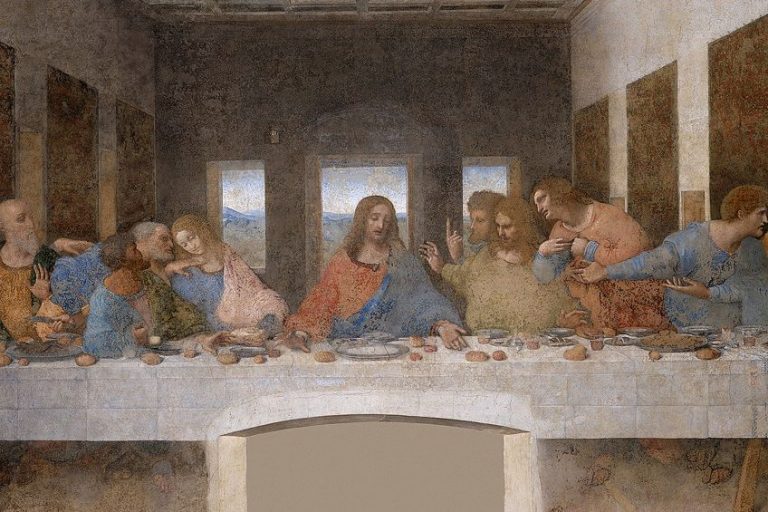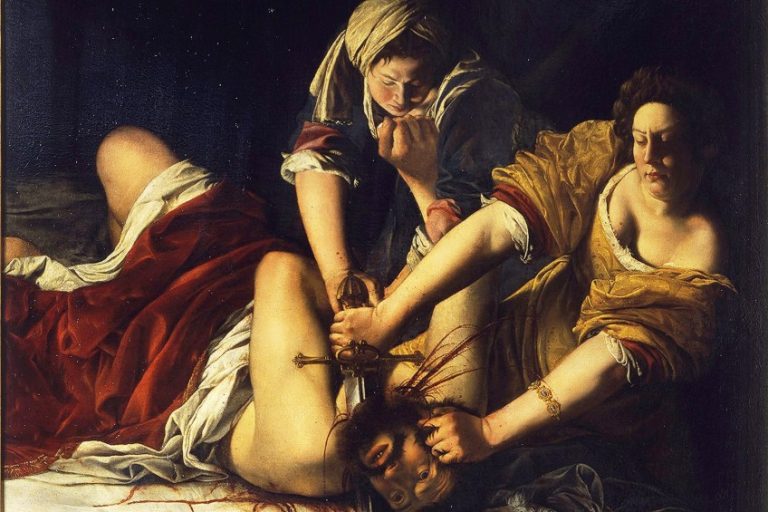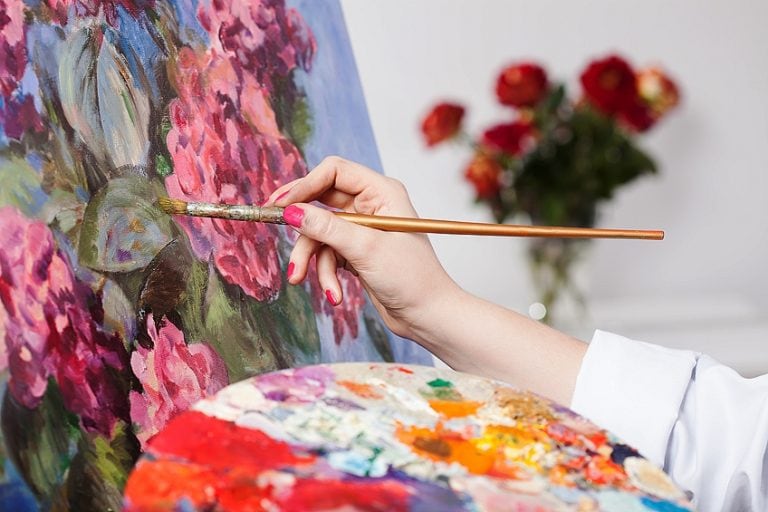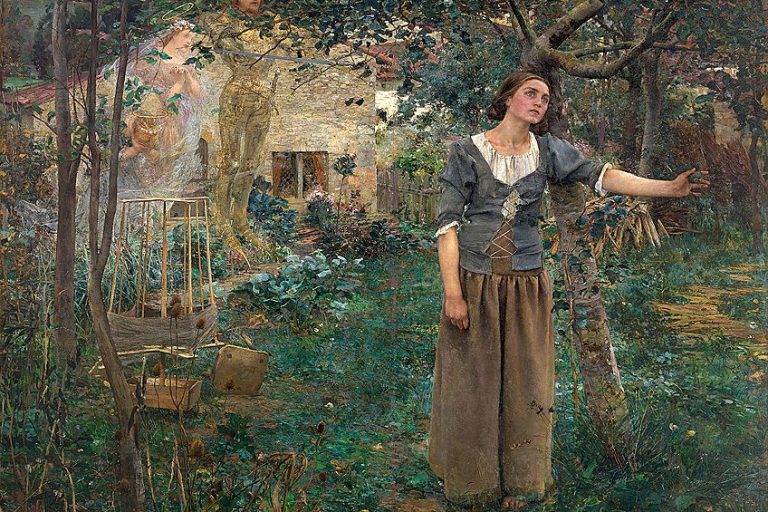Sistine Chapel Ceiling Painting by Michelangelo – Sistine Chapel Art
Imagine looking up and seeing a whirling world of figures, all engaged in different gestures and postures, poised and near to perfect. This is what you will see in the Sistine Chapel ceiling painting by Michelangelo. It is an attraction like none other in the art world, which we will discuss in this article.
Artist Abstract: Who Was Michelangelo?
Michelangelo di Lodovico Buonarroti Simoni, or Michelangelo as we know him today, was one of the great Italian High Renaissance artists, proficient in painting, sculpture, and architecture. He was born in the Arezzo province in Tuscany, Italy in a town called Caprese, although he grew up in Florence.
From an early age, he loved sculpting and was exposed to this through his nanny’s husband, who was a stonecutter.
He apprenticed under Domenico Ghirlandaio and studied at Lorenzo de’ Medici’s Humanist Academy. He was also named “The Divine One” or, in Italian, Il Divino, because of his great artistic skills. He was also famous for sculpting the great Pietà (c. 1498-1500) and David (1501-1504) statues.

The Sistine Chapel Ceiling Painting (1508-1512) by Michelangelo in Context
The Sistine Chapel ceiling painting by Michelangelo has been an attraction since its completion in 1512; it takes us on a visual journey of narratives from the Old Testament in the Bible. Before we take a closer look at the subject matter and Michelangelo’s artistic style in a formal analysis, we will first provide a brief contextual analysis of the Sistine Chapel, exploring the questions such as when was the Sistine Chapel painted? Who commissioned the Sistine Chapel ceiling? How long did it take to paint the Sistine Chapel? We will cover these as well as some other interesting facts.
| Artist | Michelangelo |
| Date Painted | 1508-1512 |
| Medium | Fresco |
| Genre | Religious painting |
| Period / Movement | High Renaissance |
| Dimensions | Dimensions vary for each painting on the Sistine Chapel Ceiling |
| Series / Versions | N/A |
| Where Is It Housed? | Sistine Chapel, Vatican City, Rome, Italy |
| What It Is Worth | Some estimates state that it is worth over $15 billion |
Contextual Analysis: A Brief Socio-Historical Overview
The Sistine Chapel, which is named Cappella Sistina in Italian, is situated in the Vatican Palace in the Vatican City in Rome, Italy. It was built in approximately 1473 and completed around 1481 by the order of Pope Sixtus IV, and was also named after him.
The Sistine Chapel was designed by the architects Baccio Pontelli and Giovannino de Dolci.
The shape of the Sistine Chapel is rectangular. Its height is over 20 meters, its length is around 40 meters, and its width is approximately over 13 meters. Many sources also state that its measurements were based on King Solomon’s Temple.

The Sistine Chapel’s interior architecture consists of a barrel-vaulted ceiling, which is a semi-circular shape. There are six arched windows along its sidewalls and two on the end walls. The chapel itself has three stories, namely, the basement, the chapel, and the upper story.
The walls are decorated in fresco paintings by artists like Sandro Botticelli, Domenico Ghirlandaio, Pietro Perugino, and Cosimo Rosselli, and depict the lives of Jesus Christ and Moses.
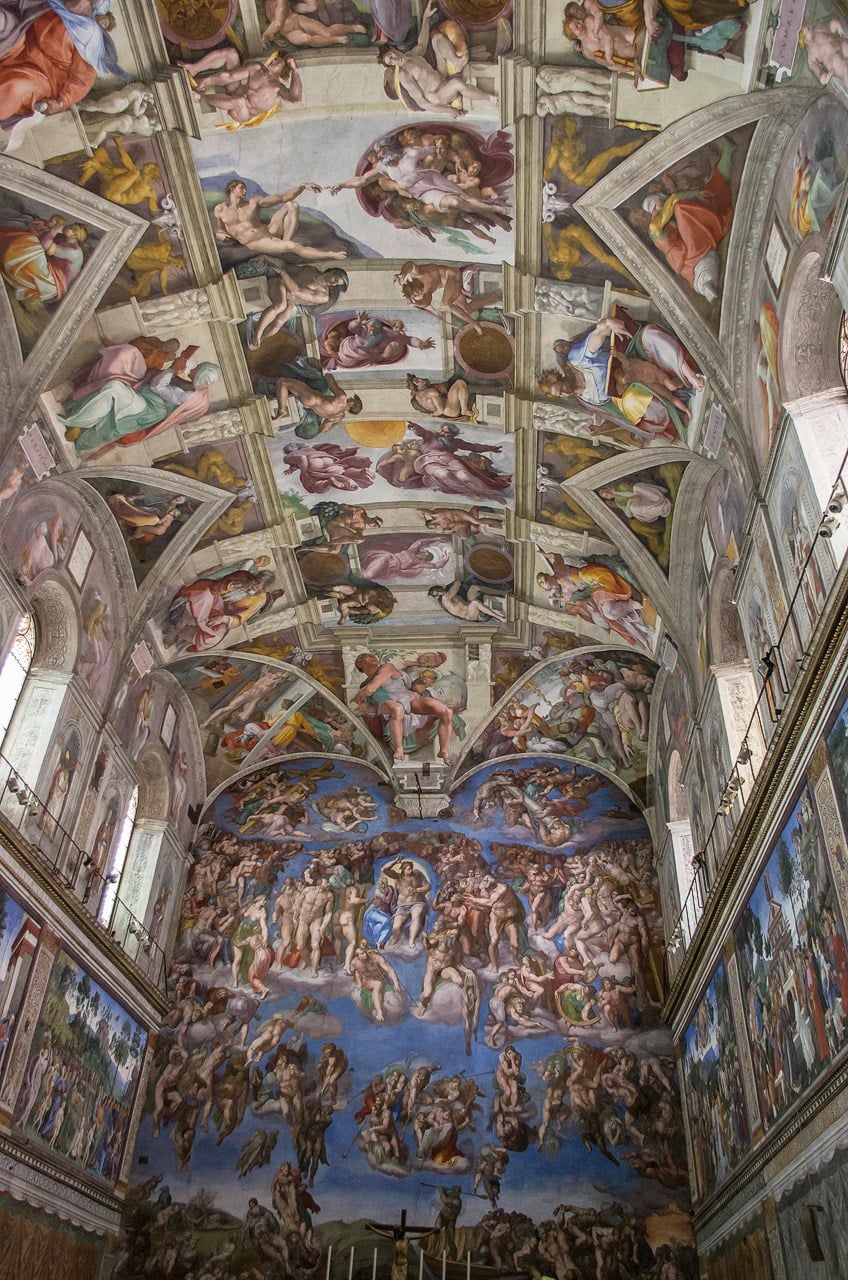
Initially, the ceiling of the Sistine Chapel resembled the night sky, painted blue with golden stars. Pope Julius II commissioned the repainting of the Sistine Chapel’s ceiling. He ruled from 1503 to 1513 and was also known as “The Warrior Pope”. Among his political prowess, he was also a patron of the arts and supported artists and architects like Raphael and Donato Bramante, as well as Michelangelo.
He continued the reconstruction of St. Peter’s Basilica that was initially planned by Pope Nicholas V. He also commissioned the famous Raphael Rooms in the Papal Palace, which are part of the Vatican Museums, also started by Pope Julius II.
Michelangelo’s Sistine Chapel Ceiling
When Pope Julius II commissioned Michelangelo to paint the ceiling of the Sistine Chapel, the artist was reportedly reluctant to do it, as he was not proficient in fresco painting. Michelangelo suggested that other painters like Raphael do the painting instead of him.
Michelangelo was already involved in other projects like Pope Julius II’s tomb and in 1508, he sculpted a bronze statue of the Pope.
However, the Pope reportedly insisted that Michelangelo should paint the Sistine Chapel ceiling, which the artist commenced in 1508. This project would last him almost four years; he completed the Sistine Chapel ceiling painting in 1512.
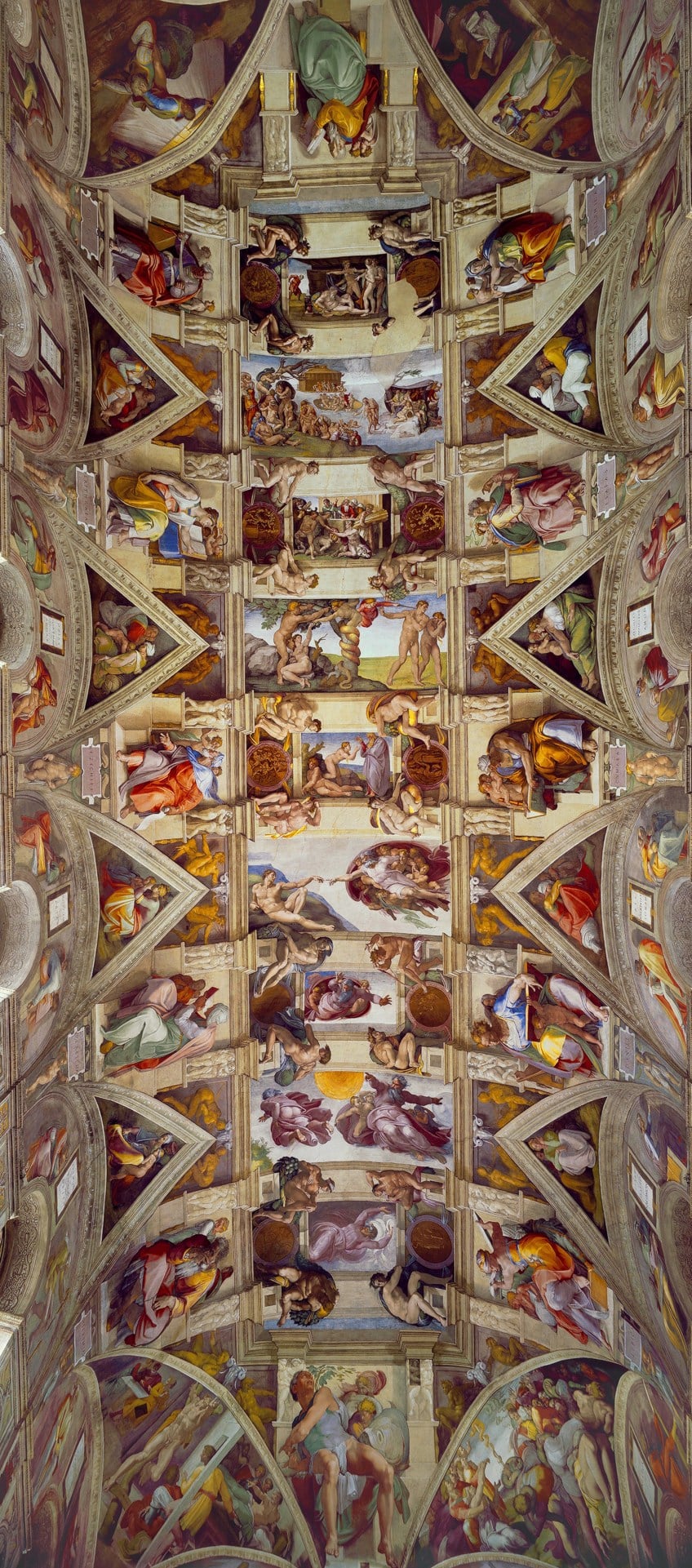
Furthermore, it was a challenging task to paint a ceiling and Michelangelo devised a plan by constructing a scaffold that he could stand on and move around while painting. However, this inevitably caused strain for the artist physically, along with poor lighting in the chapel, and he reportedly damaged his eyesight.
It has been suggested that he developed the condition called Nystagmus, described as “involuntary eye movement”. However, this condition apparently subsided a few months after the ceiling painting’s completion.
Formal Analysis: A Brief Compositional Overview
Sistine Chapel art can be quite confusing for anyone unfamiliar with it and Michelangelo’s process. Where do you start and is there an order to it? In the formal analysis below, we will look at the Sistine Chapel ceiling painting by Michelangelo, the subject matter and sequence, and the artist’s style in terms of various art elements and principles like color, texture, space, and so forth.
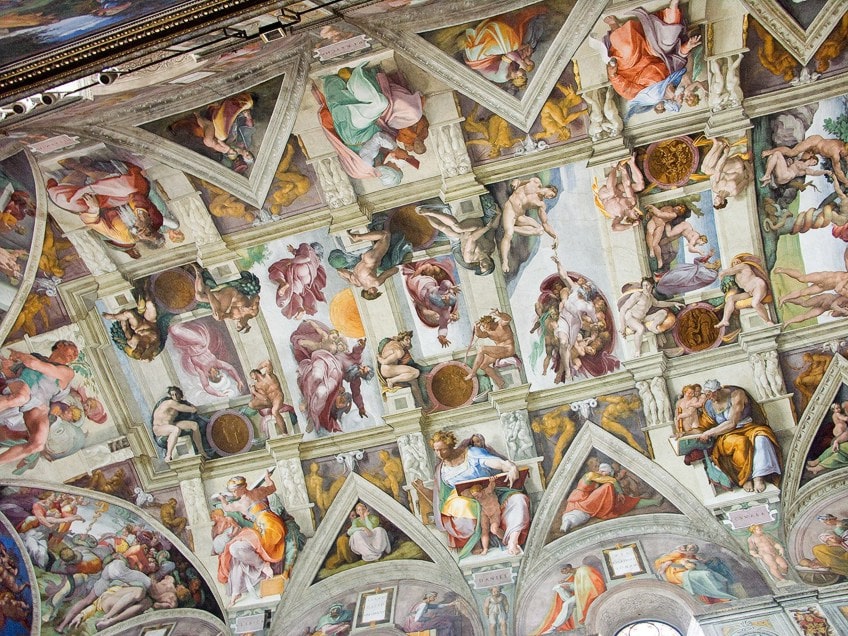
Subject Matter: The Sistine Chapel Ceiling Painting
The Pope’s plan for the ceiling of the Sistine Chapel was to paint the twelve apostles. However, Michelangelo took matters into his own hands, so to say, and instead painted narratives from the Bible’s Old Testament, the Book of Genesis.
His elaborate rendering of subject matter proved to be an immense artistic feat and the best way to understand it is to view it in its respective divisions.
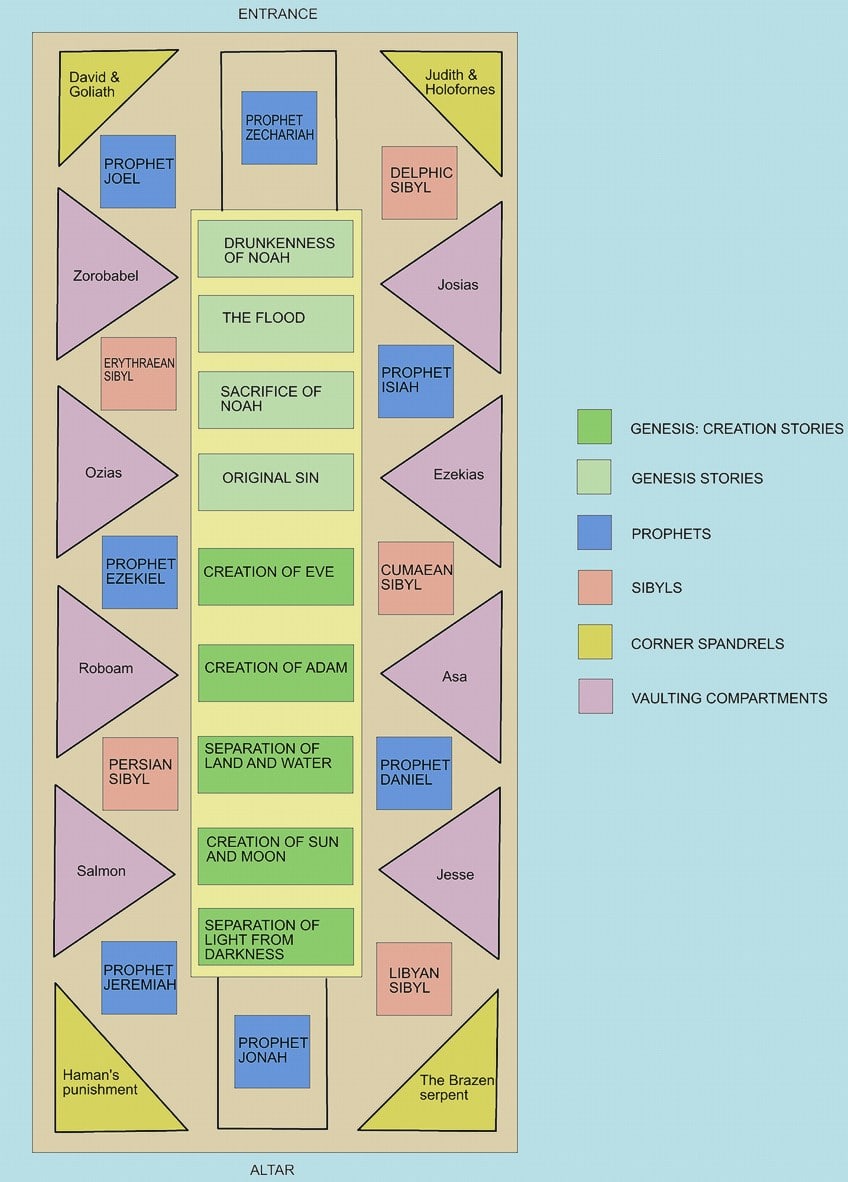
It is important to note that the central paintings on Michelangelo’s Sistine Chapel ceiling are viewed in relation to the altar, which is East-facing, and the wall depicting The Last Judgment (1536-1541) fresco by Michelangelo.

The sequence follows towards the entrance, which is West-facing, so we will start from the altar and follow our way along to the entrance. We will then work our way inwards, starting from where the North and South walls meet the ceiling. Thus, we will begin with the lunettes and move toward the central paintings.
Lunettes
In simple terms, lunettes in architecture are semi-circular structures that are often used as decoration above windows or doorways. These can also be in the form of windows. Some lunettes are also utilized as areas for paintings.
If we look at the Sistine Chapel art, the lunettes are above the sidewall windows, which are arched in shape.

There are 14 lunettes, each depicting the various ancestors of Jesus Christ and their lineage, all of whom are mentioned in the Bible’s Gospel of St. Matthew. On each lunette, there are groups of people who appear as if they are family units, and some are singular. In the center of each is a painted tablet with the respective names of the ancestors on it. All the figures show different emotional states and postures, and they are all engaged in some sort of conversation or everyday action.
An interesting fact about these scenes is that all the figures seem to be languishing in their emotional states.
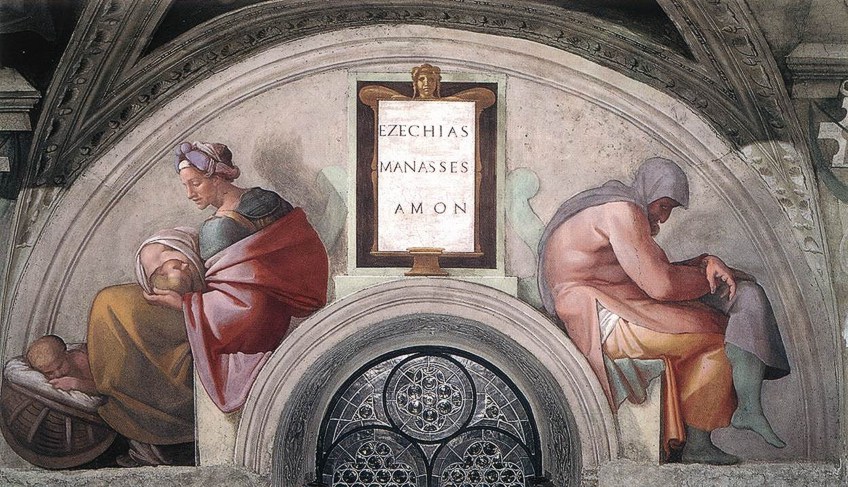
Pendentives
Pendentives in architecture refer to triangular structures from a dome over a square or rectangular building shape. There are four pendentives in each corner of the Sistine Chapel ceiling, which depict scenes about the salvation of Israel. Starting from the altar side, the left pendentive depicts the narrative of the Punishment of Haman and the right depicts the Brazen Serpent.
If we look at the pendentives towards the entrance, to the left is the scene of Judith and Holofernes and to the right is that of David and Goliath.

Spandrels
Spandrels are also triangular shapes that are typically found between an arched or curved and rectangular architectural structure. There are eight spandrels along the sides of the Sistine Chapel ceiling depicting family scenes.
Some also believe that these are continuations of the family scenes we see on the lunettes mentioned above, although the accuracy of their identities has been debated and is unclear.

Sybils and Prophets
Depicted between the spandrels mentioned above are twelve larger, alternating, portrayals of seated Sybils, of whom there are five, and prophets, of whom there are seven. They are seers of the coming of Jesus Christ and refer to the narrative of redemption.
There is one figure positioned on the altar’s end, who is the prophet named Jonah, and one near the entrance’s end, who is the Prophet Zechariah.
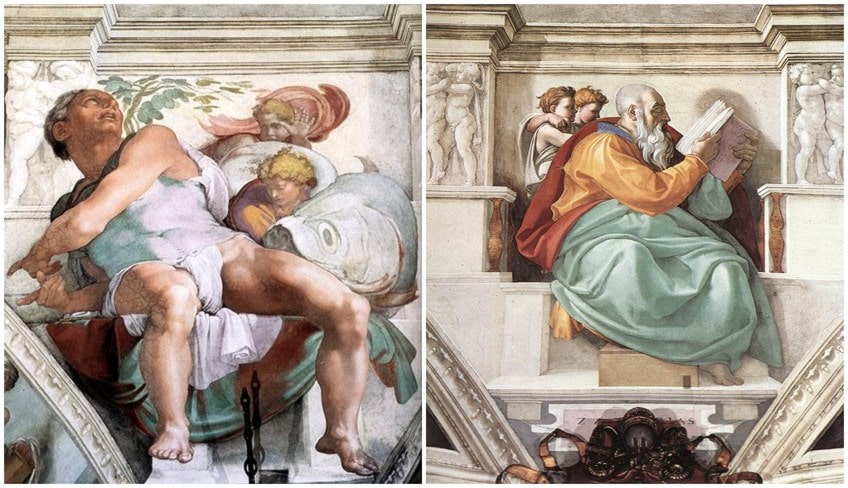
Starting from the altar’s end on the North wall is the Libyan Sibyl “LIBICA”. Next to her is the prophet “DANIEL”; the Cumaean Sibyl “CVMAEA”; the prophet Isaiah, named as “ESAIAS”; and then the Delphic Sibyl “DELPHICA”. From the altar’s side on the South Wall are the “weeping prophet” Jeremiah, named as “HIEREMIAS”; the Persian Sibyl “PERSICHA”; the prophet Ezekial, named as “EZECHIEL”; the Erythrian Sibyl “ERITHRAEA”; and then the prophet Joel, named as “IOEL”.
All the figures are identified by what appears to be a plaque with their names on it below them. Apart from the two figures at either end, the other plaques are held or supported by what is referred to as putti, or a putto in the singular form.
These are usually nude children, plump in body composition, and often symbolize cherubs or cupids.

We will also notice these putti on plinths flanking each figure. However, here Michelangelo skillfully painted them to appear as three-dimensional architectural motifs. We will notice this technique utilized throughout the Sistine Chapel ceiling and will discuss it in more detail below.
The Central Paintings of the Vaulted Ceiling
The central part of the Sistine Chapel ceiling consists of nine scenes, which are further grouped into threes depicting three different stories from the Bible’s Book of Genesis. The compositional layout alternates between a smaller painting with two medallions on each side of it, which Michelangelo painted to appear bronze, and then a larger rectangular painting.
The first three scenes are about God’s creation of Heaven and Earth.
These are namely, and in consecutive order along with the ceiling, the Separation of Light from Darkness from Genesis, verse 1: 1-5; Creation of the Sun, Moon, and Plants from verse 1: 11-19; and the Separation of Land from Sea from verse 1: 9-10.
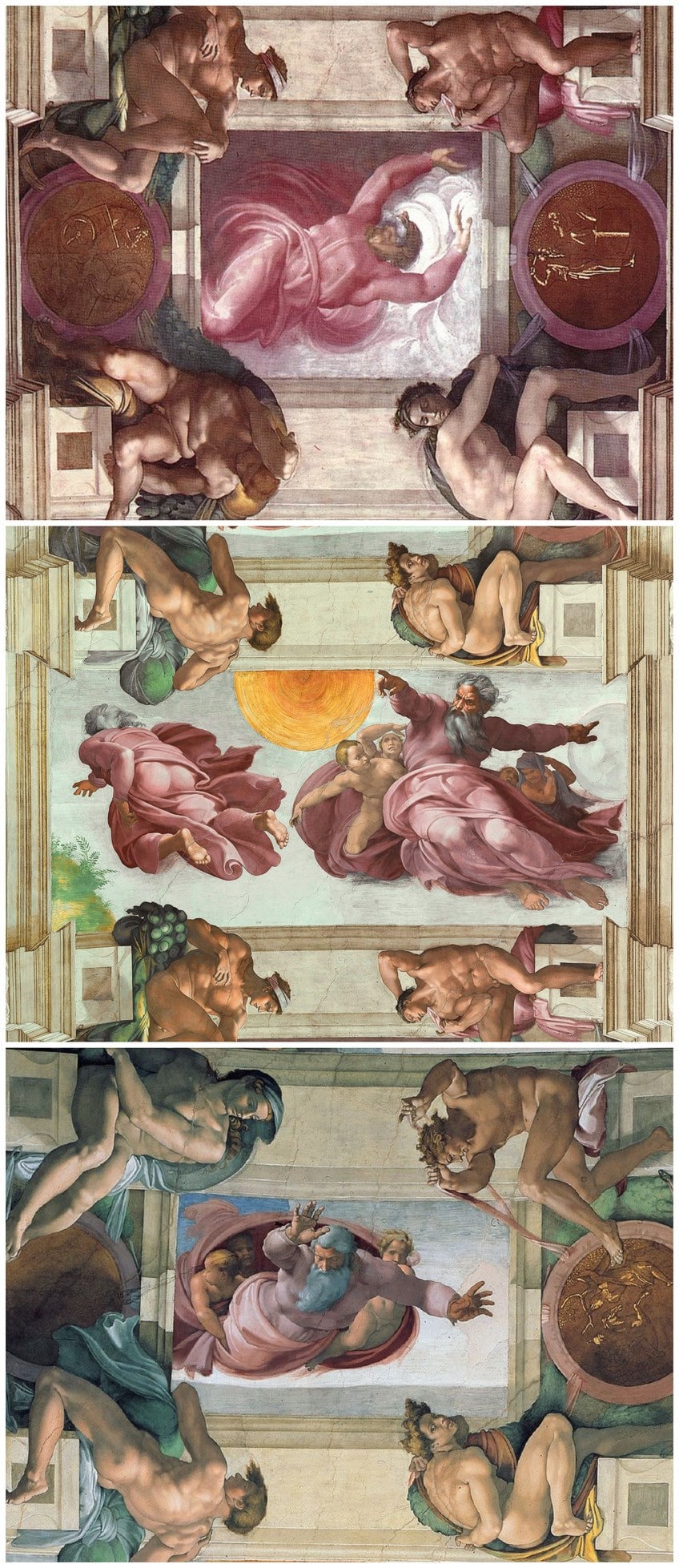
The second group of threes is about God’s creation of man, starting with what has become one of the most famous Renaissance paintings by Michelangelo, being the Creation of Adam. In addition to the Creation of Adam from Genesis, verse 1: 26-27, other paintings include scenes from the Creation of Eve from verse 2: 18-25, as well as the Original Sin and Banishment from the Garden of Eden from verse 3: 1-13 and verse 3: 22-24.
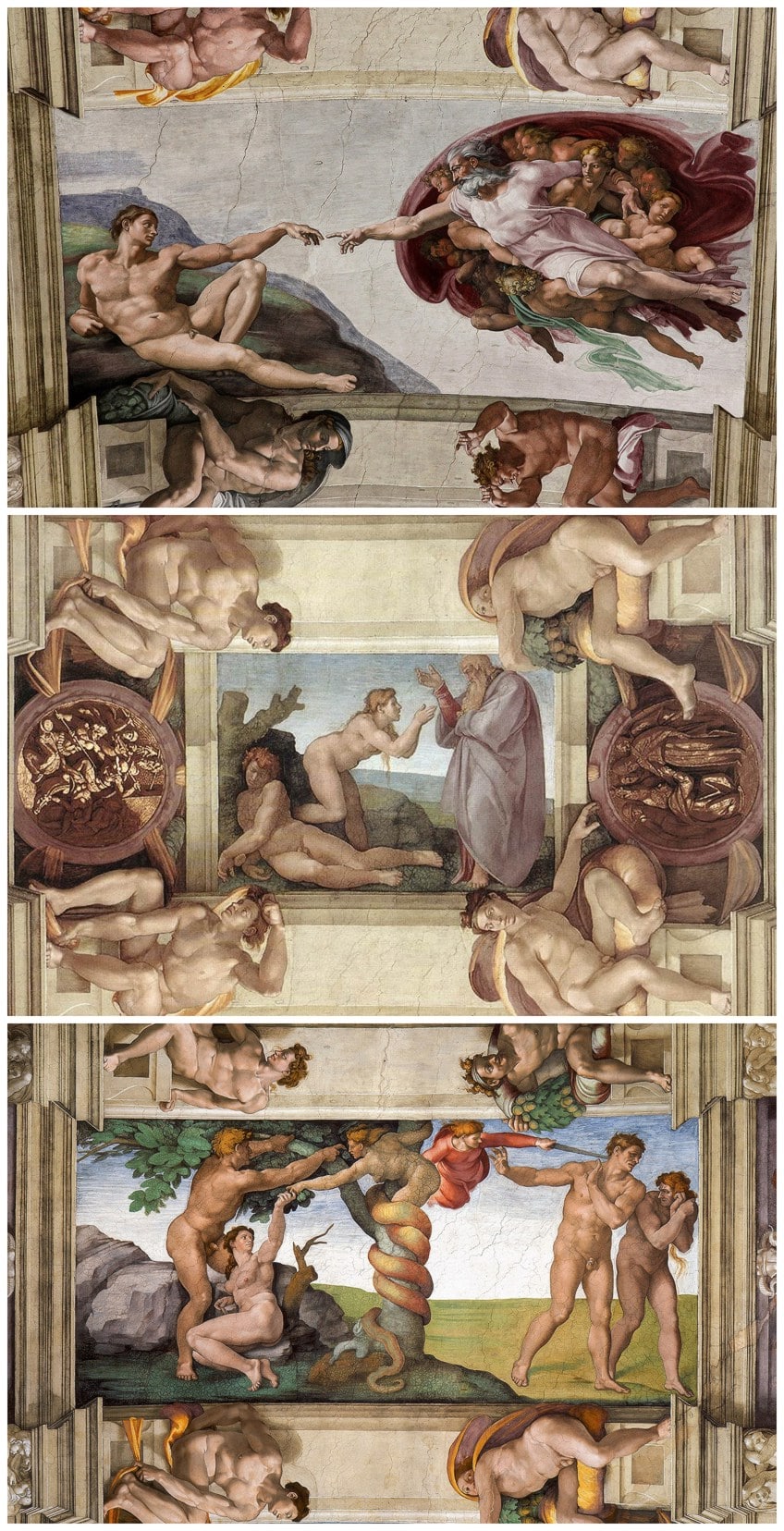
The third group of threes is about Noah and the Flood, starting with the Sacrifice of Noah from Genesis, verse 8: 15-20; followed by The Flood or Deluge from verse 6: 5-20; and lastly, the Drunkenness of Noah from verse 9: 20-27.

Medallions
There are 10 Medallions altogether, and these have been believed to depict scenes from the Old Testament in the Bible, specifically woodcut illustrations from the Italian-translated Bible from 1493, which was translated by Niccolò Malermi.
He translated the Bible from Latin into Italian, which was originally done in 1471. This Bible was also called the “Malermi Bible”.
The scholar and historian Edgar Wind wrote about this in his paper/article Maccabean Histories in the Sistine Ceiling (1960), published in the Italian Renaissance Studies: A Tribute to the Late Cecilia M. Ady. He also discussed how some of the scenes on the medallions referred to the Maccabees, a group of Jewish priests during the 2nd-century BCE who revolted against the Greek Seleucid Empire.
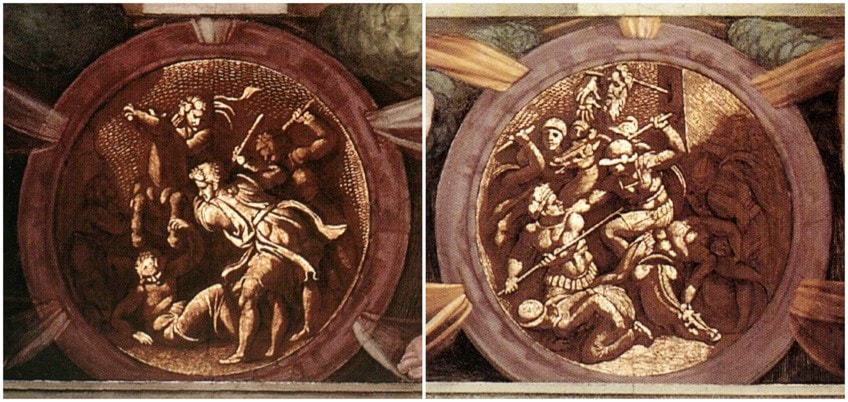
Ignudi
If we look at the central panel of paintings again, we will notice that there are four nude male figures posed at each corner of the small paintings. They are referred to as the ignudi, or in singular, ignudo, which is an Italian word meaning “naked” or “nude”. In total, there are 20 figures, all seated in different poses on plinths. Interestingly, below each plinth are the putti statuettes we previously discussed.
The male nudes appear to be holding and supporting the medallions between them with large pieces of fabric or ribbons.
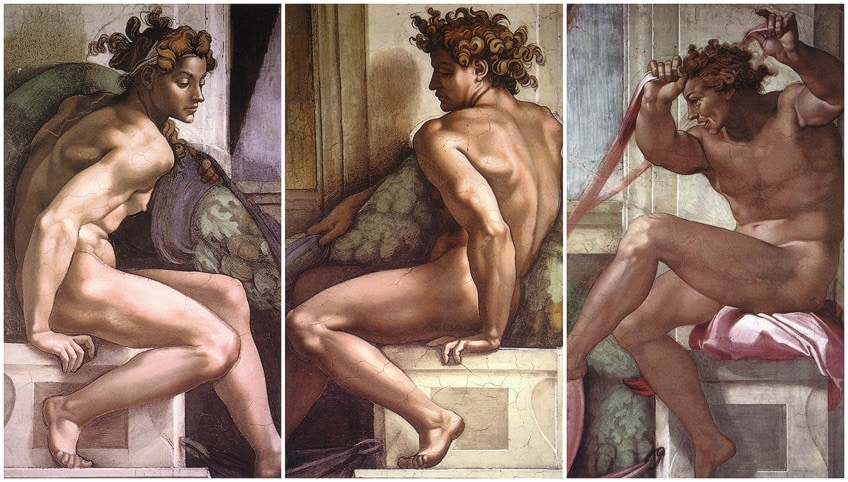
Michelangelo, Public domain, via Wikimedia Commons | MIDDLE: Michelangelo, Public domain, via Wikimedia Commons | RIGHT: Michelangelo, Public domain, via Wikimedia Commons
Color and Value
The Sistine Chapel ceiling painting by Michelangelo was painted as a fresco, which is a painting style or technique involving the application of a pigment, which is combined with water, to wet lime plaster. This technique has been described as fairly difficult due to the time constraints of painting from the drying plaster.
As previously mentioned, Michelangelo did not have extensive experience with fresco painting, being mostly a sculptor, but he produced a masterpiece in the end.
The colors of the Sistine Chapel painting lost their luster over the years due to smoke from candles and various other damaging causes. However, a major restoration from around 1979 to 1994 revealed more of the luminosity of its colors.
From pastels like greens, yellows, blues, light pinks, and peaches to darker browns and blues, the Sistine Chapel painting depicts a spectrum of colors that gives it life and animation. Furthermore, the combination of cooler and warm colors gives it an overall balanced and harmonious effect.
Michelangelo also conveyed light and dark areas through shading and toning on the figures, their costumes, and various paraphernalia.
There are some areas that appear contrasted in light and dark, such as in The Creation of Adam, where we see a light background with the darker set figures of God and Adam in the foreground. Some sources have explained that Michelangelo utilized this technique so that the painting could be better viewed from below.

Texture
There is an overall smooth texture from the paint on the Sistine Chapel ceiling. Michelangelo created an implied texture in various subjects of the Sistine Chapel painting, such as in the figures’ robes, their hair, and smooth skin tones.
Importantly, Michelangelo painted the implied architectural features around the figures, which gives the illusion of marble. This also applies to the medallions between the ignudi, which appear to be bronze.
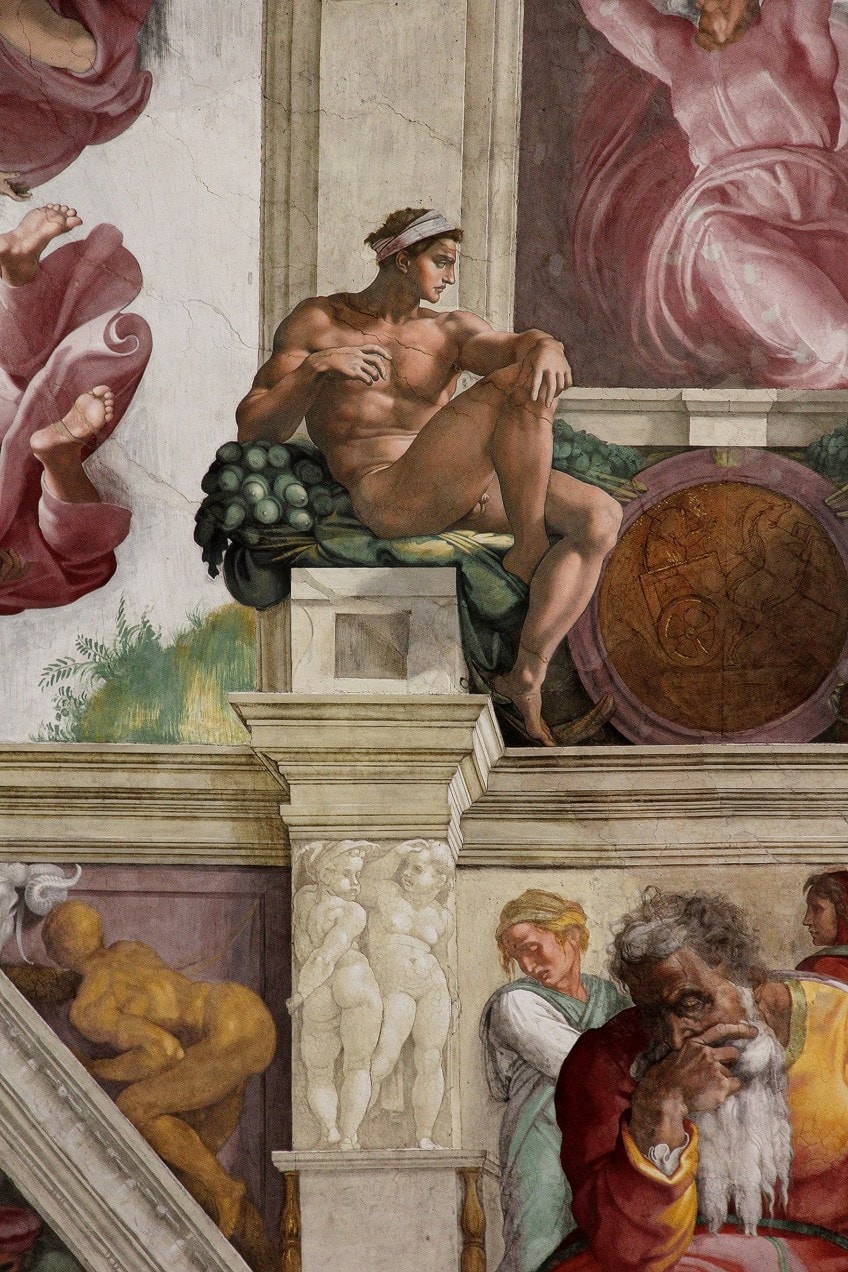
Line, Form, and Shape
Michelangelo utilized a variety of lines, forms, and shapes in the Sistine Chapel ceiling paintings. If we look at the central paintings, The Creation of Adam has become a cornerstone example, and in it we see a horizontal line forming between the figure of Adam to the left and God to the right as their fingertips are about to touch.
Furthermore, their outstretched arms create a horizontal line across the composition, giving it a balancing effect.
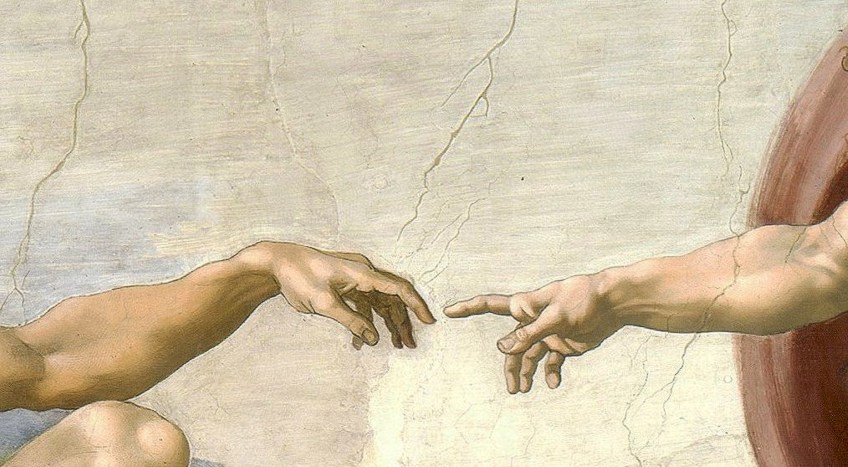
If we look at how Michelangelo utilized form, the human form mainly dominates and is explored in detail in the entirety of the Sistine Chapel ceiling paintings. An example often referred to by art sources is that of the Libyan Sibyl (c. 1510-1511). Michelangelo depicted her in a dynamic pose, where she is reaching for a large book and her body is naturally twisting in the process.
We can see the detail in her feet as she balances herself.
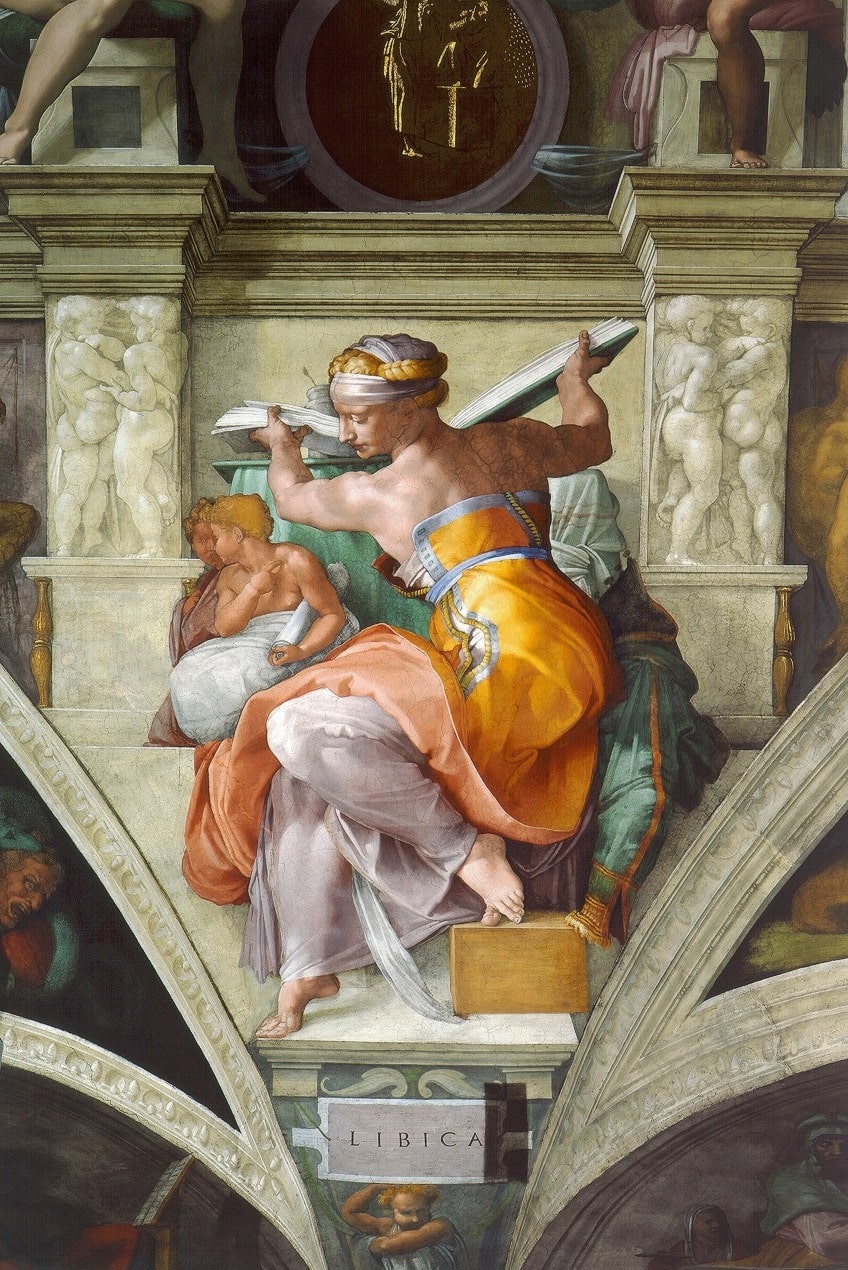
Coupled with her large scale, the Libyan Sybil is also physically strong in appearance. Her upper back muscles reveal this, but also reveal Michelangelo’s attention to human anatomy and realism of form. The artist also produced drawing studies for the Libyan Sybil, which are housed in the Metropolitan Museum of Art in New York City, the United States of America.
There appear to be more organic and curving forms in the paintings, as can be seen in the figures, their drapery, the circular shapes of the medallions, and other objects.
These are seemingly contrasted with the more linear and geometric forms from the implied and real architectural space around them like the vaulted ceiling, painted columns and plinths, and the triangular shapes of the spandrels.
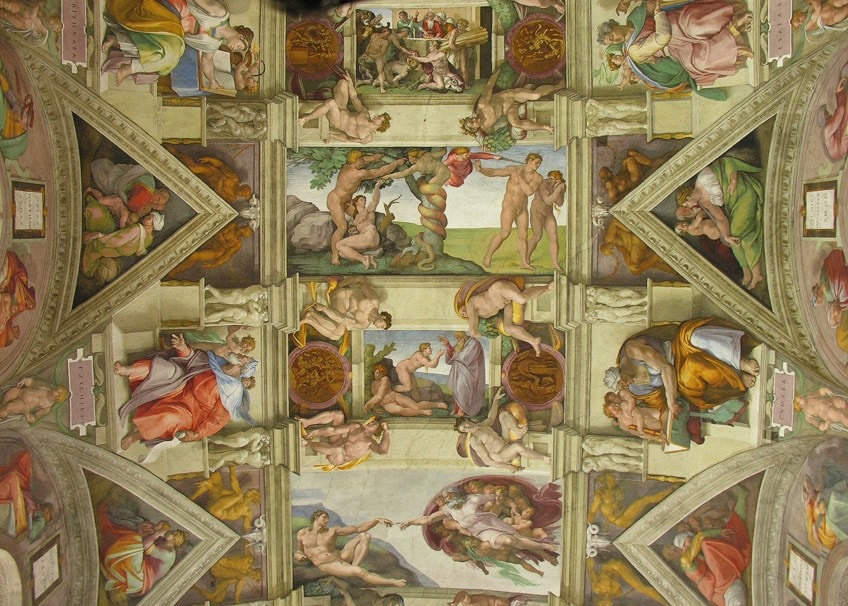
Space
Other aspects of form relate to the art element of space, which interplay with how Michelangelo rendered the subject matter on the ceiling of the Sistine Chapel. There is a three-dimensionality when we look up, as if the ceiling is composed of various columns and plinths, but these are merely painted illusions of structural forms. This was a common technique utilized in Renaissance paintings to explore perspective and spatial depth, referred to as trompe l’oeil, which is a French term, translated to “deceive the eye” in English.
This was often done by using elements like color and contrasting light and shadow, as well as by depicting figures or objects on larger or smaller scales.

The Sistine Chapel Ceiling Painting: A Sight for Sore Eyes
Pope Julius II died in 1513, only a few months after Michelangelo completed the Sistine Chapel ceiling. Since its creation, it has become one of the greatest fresco paintings in art history and the subject of study for many other artists over the centuries.
While this article has only touched upon the surface of Michelangelo’s Sistine Chapel ceiling painting’s subject matter and its meanings, there is ultimately a whole other world waiting to be explored in more depth and it is encouraged that you delve deeper into its mysteries.
Frequently Asked Questions
Who Painted the Ceiling of the Sistine Chapel?
The Renaissance painter and sculptor Michelangelo painted the ceiling of the Sistine Chapel. He was commissioned by Pope Julius II, who initially only wanted the twelve apostles and a design on the ceiling, but Michelangelo changed the composition to depict various scenes from the creation to the destruction of man.
When Was the Sistine Chapel Painted?
The Sistine Chapel ceiling painting by Michelangelo was started in 1508 and completed in 1512. This was during the Renaissance, specifically the period referred to as the High Renaissance, during which other famous painters like Leonardo da Vinci and Raphael were active.
How Long Did It Take to Paint the Sistine Chapel?
It took Michelangelo almost four years to complete the ceiling of the Sistine Chapel. He first started painting the Sistine Chapel’s ceiling in 1508, which was commissioned by Pope Julius II as a project to repaint the original ceiling, which was blue with stars. He finished it in 1512, although, during the four years, he reportedly took a break for one year in around 1510.
Isabella studied at the University of Cape Town in South Africa and graduated with a Bachelor of Arts majoring in English Literature & Language and Psychology. Throughout her undergraduate years, she took Art History as an additional subject and absolutely loved it. Building on from her art history knowledge that began in high school, art has always been a particular area of fascination for her. From learning about artworks previously unknown to her, or sharpening her existing understanding of specific works, the ability to continue learning within this interesting sphere excites her greatly.
Her focal points of interest in art history encompass profiling specific artists and art movements, as it is these areas where she is able to really dig deep into the rich narrative of the art world. Additionally, she particularly enjoys exploring the different artistic styles of the 20th century, as well as the important impact that female artists have had on the development of art history.
Learn more about Isabella Meyer and the Art in Context Team.
Cite this Article
Isabella, Meyer, “Sistine Chapel Ceiling Painting by Michelangelo – Sistine Chapel Art.” Art in Context. June 3, 2022. URL: https://artincontext.org/sistine-chapel-ceiling-painting-by-michelangelo/
Meyer, I. (2022, 3 June). Sistine Chapel Ceiling Painting by Michelangelo – Sistine Chapel Art. Art in Context. https://artincontext.org/sistine-chapel-ceiling-painting-by-michelangelo/
Meyer, Isabella. “Sistine Chapel Ceiling Painting by Michelangelo – Sistine Chapel Art.” Art in Context, June 3, 2022. https://artincontext.org/sistine-chapel-ceiling-painting-by-michelangelo/.




